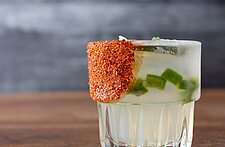By Chef Ron Spaziani
One of the core lessons that I was taught in Culinary School is to not burn or over cook items when using techniques that involve smoking, grilling or charring. So why are chefs ignoring the whole “thou-shall-not-burn” thing and purposely taking their food to the burnt bitter dark side?
As we many know it, smoking is one of the oldest methods of food preservation, being used shortly after the development of cooking with fire. The practice attained high levels of sophistication in several cultures, notably the smoking of fish in Scandinavia and northwestern North America and the production of smoked hams in Europe and the United States. So why are chefs utilizing techniques from back in the day?
CLICK HERE to view Culinary Chronicles: Vegetables Step Up to the Plate
Lately in kitchens across the country, more chefs are fully embracing the flavor of fire by charring vegetables, burning beef, infusing charcoal into oil, and even folding ashes into fresh loaves of dough. The sweet, smoky char you get from a burger cooked over open coals or the hickory smoke of a cookout - that’s all being channeled into your dinner. So is black really the new black? The trend started in fine dining when high-end chefs, presumably bored with cooking everything perfectly all of the time. They blistered and charred vegetables, meats, and even desserts.
Chefs are utilizing old culinary techniques to build back more depth and layers of flavors into classic dishes making them more natural tasting rather than using artificial items. Charring, scorching and smoking will add flavor notes of bold bitter, as well as enhancement. In order to impact the right smoky flavor, chefs use different types of wood, a range of temperatures and different amounts of time. Not only does smoke impart a rich flavor to almost anything from cocktails to entrees, the accompanying show is an added bonus for customers. People eat with all five of their senses, and aromas and sounds from the grill add to the flavor.
CLICK HERE for more Culinary Chronicles, delivered to your inbox
Besides looking cool, chefs say that smoke’s subtle flavors and comforting aromas appeal to guests. “Using smoke is a great way to enhance the natural flavors of the dish, as well as drive some of the flavors of the smoke itself into the dish. Smoke is also a fantastic way to add an artful touch that helps us engage with guests.”
Here is one of my Favorite Burnt Dishes I like to cook.
Charred Figs and Prosciutto Flatbread with Burnt Onions and Balsamic Reduction
One portion of pizza dough
6-10 figs, quartered and charred
2 Cloves of Roasted Garlic
4-6 slices prosciutto
Ricotta cheese
Sautéed mushrooms and Arugula

Burnt caramelized onions
Fresh basil
Balsamic reduction
Salt & Pepper to Taste
If you want to incorporate more bitter tastes into your cooking, take some suggestions from below. Remember that sweet, sour, and salt balance bitter out. Fat can also smooth it out. Think sweet BBQ sauce on charred meat, lemon juice on beet greens, salt on burnt caramel, and bacon with brussels sprouts.

Image: foodanddrinkresources.com/food-trend-bitter

Why chefs are burning your food intentionally

In restaurants these days, black may well be the new black. Charred, crispy textures and ingredients -- no longer limited to the world of barbecue -- are blackening everything from bread to vegetables. Not even dessert is safe. Yeah, it may look, feel and taste a little gritty, even a little ashy, but that's kind of the point, chefs say.

Chefs use smoke to bring 'wow' factor to the table

Dishes like Duet Restaurant's smoking Kobe beef tartare are ideal Instagram bait. Everyone loves a show. From flames igniting a Bananas Foster to a larger-than-life hot fudge sundae making its way across a crowded dining room, operators love to hear guests say, "I want what she's having."

10 Foods That Taste Better Burnt

When you're learning how to cook, there are a number of things you try not to do, and burning your food is one of them. It's time to break the rules because sometimes food just tastes better when burnt. We're not talking about leaving your chicken in the oven four hours too long (poultry doesn't do well if not cooked perfectly).

If there's smoke, will consumer desire catch fire?

Smoke flavor is becoming trendy, and is often added to items like meat and vegetables, as well as nontraditional places like butter, fruit, yogurt and desserts. In order to impart the right smoky flavor, chefs and manufacturers use different types of wood, different temperatures and different amounts of time.

(Intentionally!) Burnt and Charred Food Recipes - Bon Appétit

Burnt or charred food can be a great thing when you do it right-it adds a whole new layer of flavor.

Black Is the New Black: 9 Dishes Featuring Burned Food on Purpose

Although I'm not exactly a culinary school graduate-the last time I cooked dinner I think a Bush was president-I imagine that not burning things is one of the core lessons they teach there. And yet many top chefs are ignoring the whole thou-shall-not-burn thing and are purposely burning their food.






